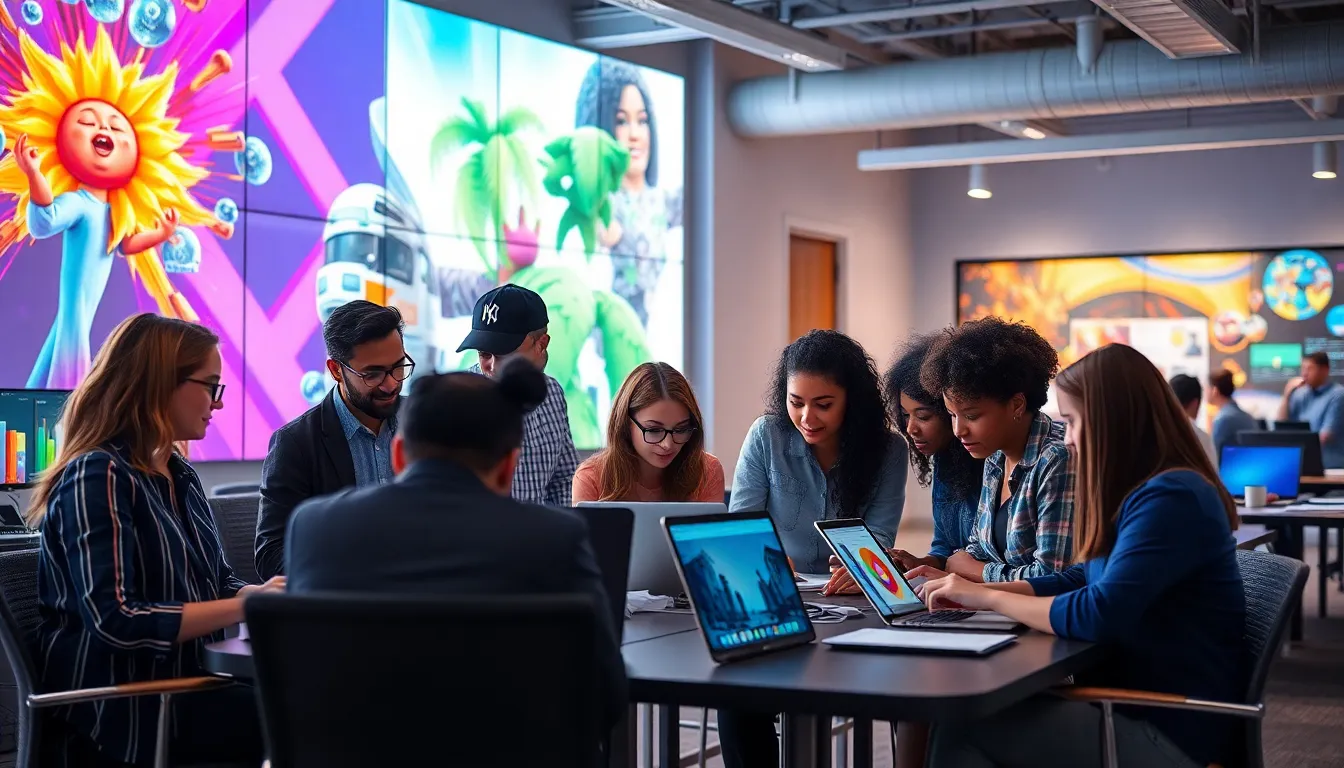Table of Contents
ToggleDigital media technology has transformed the way people communicate, consume information, and engage with content. From social media platforms to streaming services, these innovations have reshaped everyday life, making it more interconnected than ever. As technology continues to evolve, it brings both exciting opportunities and unique challenges that impact individuals and businesses alike.
Understanding digital media technology is crucial for navigating this fast-paced landscape. It not only influences marketing strategies and consumer behavior but also shapes cultural trends and social interactions. By exploring the latest advancements and their implications, one can gain valuable insights into how digital media is redefining the way society operates.
Overview of Digital Media Technology
Digital media technology encompasses a range of tools and platforms that facilitate the creation, distribution, and consumption of content. This category includes social media networks, streaming services, mobile applications, and websites. Innovations in these areas have fundamentally changed how individuals access information and interact with one another.
Digital media empowers users to create content easily. Platforms like YouTube, TikTok, and Instagram enable users to produce videos and images without professional equipment. Accessibility fosters a participatory culture where anyone can contribute, shaping trends and discussions in real time.
Services such as Netflix, Spotify, and Hulu have transformed entertainment consumption. These platforms utilize streaming technology, allowing for on-demand access to vast libraries of content. Users benefit from personalized recommendations, enhancing the viewing and listening experience.
Digital media technology also plays a critical role in marketing strategies. Businesses increasingly adopt online advertising and social media marketing to reach target audiences effectively. Data analytics guide tailored campaigns, optimizing engagement and conversion rates.
The integration of artificial intelligence and machine learning further amplifies digital media technology’s impact. Algorithms analyze user behavior, predicting preferences and generating content recommendations. Such advancements streamline user experiences and drive platform growth.
Understanding digital media technology remains essential for navigating contemporary society. The rapid evolution of trends and platforms challenges users and businesses alike to adapt and innovate continually. Embracing these technologies fosters not only engagement but also an informed approach to emerging digital landscapes.
Key Components of Digital Media Technology

Digital media technology comprises various hardware and software elements that enable the creation, distribution, and consumption of digital content. The components below play a crucial role in shaping interactions within the digital landscape.
Hardware Innovations
- Computing Devices: Laptops, desktops, smartphones, and tablets facilitate content creation and consumption across various formats. Powerful processors and high-resolution displays enhance user experiences.
- Networking Equipment: Routers, modems, and switches ensure stable internet connectivity, enabling seamless access to online content. Improved bandwidth supports higher-quality streaming and faster downloads.
- Audio-Visual Gear: Cameras, microphones, and editing equipment allow content creators to produce high-quality videos and audio. The availability of affordable equipment has democratized content creation.
- Storage Solutions: Cloud services and external drives provide ample space for storing digital assets. Efficient storage options support easy access to and backup of valuable content.
Software Developments
- Content Management Systems (CMS): Platforms like WordPress and Drupal simplify the publishing process. These systems allow users to create, edit, and manage digital content without extensive technical skills.
- Design Software: Tools such as Adobe Creative Suite enhance visual content creation. Software like Photoshop and Illustrator enables designers to produce compelling graphics and multimedia materials.
- Streaming Applications: Services like Netflix, Hulu, and Spotify revolutionize content delivery. These applications offer on-demand access to a wide array of media, employing algorithms to personalize user recommendations.
- Social Media Platforms: Sites like Facebook, Twitter, and Instagram empower users to share content widely. These platforms facilitate interactions, promote engagement, and serve as key marketing channels for businesses.
These key components underpin the functionality of digital media technology, enabling transformative interactions and continuous innovation.
Impact of Digital Media Technology
Digital media technology significantly influences various aspects of life, particularly communication and entertainment. The ability to connect with others and access diverse content instantaneously transforms daily experiences and interactions.
On Communication
Digital media technology reshapes how individuals communicate. Platforms such as social media networks and messaging applications facilitate real-time conversations across geographical boundaries. Users engage in discussions, share opinions, and participate in global dialogues. This immediacy creates stronger connections among individuals, allowing for the dissemination of information at unprecedented speeds. Businesses leverage these channels for customer interactions, enabling timely responses and personalized experiences. Furthermore, the rise of video conferencing tools supports remote collaboration, making teamwork flexible and efficient.
On Entertainment
Digital media technology revolutionizes entertainment consumption patterns. Streaming services like Netflix, Hulu, and Spotify provide users with on-demand access to extensive libraries, shifting away from traditional viewing habits. Personalized content recommendations enhance user experiences, ensuring that consumers receive tailored suggestions based on their preferences. Additionally, user-generated content platforms enable individuals to share creative works, fostering a culture of innovation and collaboration. This environment encourages diverse content sharing, driving engagement and transforming how audiences consume and interact with media.
Challenges in Digital Media Technology
Digital media technology presents various challenges that impact users and organizations alike. Key issues include privacy concerns and data security problems.
Privacy Concerns
Privacy concerns arise as digital media platforms collect and utilize user data. They track behaviors, preferences, and interactions, facilitating targeted advertising and personalized content delivery. Users often lack awareness about the extent of data collection and the potential misuse of their information. Regulations like the General Data Protection Regulation (GDPR) emphasize the need for transparency in data handling, compelling organizations to adopt stricter privacy policies. Moreover, breaches in trust can lead to significant reputational damage for brands, highlighting the importance of safeguarding user privacy.
Data Security Issues
Data security issues persist across digital media technologies, posing risks to sensitive user information. Cyberattacks, such as data breaches and hacking incidents, compromise personal and financial data stored on platforms. High-profile cases illustrate the vulnerability of even major companies, leading to substantial financial losses and legal repercussions. Organizations must implement robust measures to secure data, including encryption, frequent software updates, and user awareness training. Continually evolving threats necessitate ongoing vigilance and innovation to protect digital assets and maintain user trust.
Future Trends in Digital Media Technology
Digital media technology is set to evolve rapidly in the coming years, with several trends likely to shape its trajectory.
- Enhanced User Experiences
User experiences will improve with advancements in virtual reality (VR) and augmented reality (AR). These technologies provide immersive interactions, allowing users to engage with content in unprecedented ways. Applications for gaming, education, and virtual events will become more prevalent.
- AI-Driven Content Creation
AI-driven tools will streamline content creation. Algorithms can generate personalized articles, videos, and graphics, catering to specific audience preferences. This technology will empower creators by reducing the time and resources needed for production.
- Improved Data Privacy Measures
Increased awareness of privacy issues will drive stronger data protection regulations. Companies will implement more transparent data handling practices and adopt privacy-respecting technologies, enhancing user trust.
- Interactive and Live Streaming
Live streaming will dominate digital media platforms. Real-time interactions with audiences will become essential for brands and content creators seeking authentic engagement. Interactive features, such as polls and live Q&A sessions, will involve audiences more deeply.
- Integration of Blockchain Technology
Blockchain technology will transform content distribution and ownership. Decentralized platforms offer creators secure, transparent ways to manage copyrights and monetization, reducing reliance on traditional middlemen.
- 5G Connectivity
Widespread 5G adoption will facilitate faster, more reliable streaming and content delivery. Enhanced bandwidth will support higher quality video, enabling seamless access to resources like 4K and virtual reality content.
- Sustainability in Digital Practices
Sustainability will gain prominence. Digital media companies will adopt greener practices, focusing on reducing carbon footprints associated with data centers and streaming services. This trend will resonate with environmentally conscious consumers.
- Voice and Visual Search Optimization
Voice-activated devices and visual search technology will influence content strategies. Marketers will optimize content for voice searches and visual inquiries, adapting to changing consumer behavior.
These trends reflect the dynamic nature of digital media technology, highlighting the need for continuous adaptation among users and businesses. Each trend marks a significant step toward redefining how individuals engage with and experience digital content.
Digital media technology is reshaping how individuals and businesses interact in an increasingly connected world. Its influence on communication and entertainment is profound, offering new avenues for engagement and creativity. As trends evolve, adapting to these changes becomes essential for success.
The challenges of privacy and data security can’t be overlooked. Organizations must prioritize transparency and robust security measures to maintain user trust. Looking ahead, innovations like AI, VR, and improved connectivity will continue to drive the digital landscape forward.
Staying informed and agile in this dynamic environment will empower users and businesses alike to harness the full potential of digital media technology. Embracing these advancements will pave the way for richer experiences and more meaningful connections in the digital realm.







